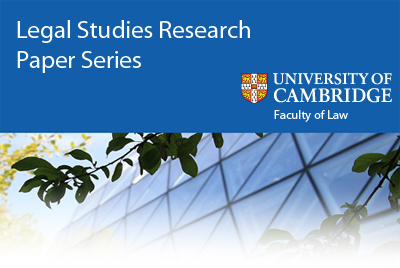 The Faculty has published Volume 5 Number 8 of the University of Cambridge Faculty of Law Legal Studies Research Paper Series on SSRN.
The Faculty has published Volume 5 Number 8 of the University of Cambridge Faculty of Law Legal Studies Research Paper Series on SSRN.
This issue includes the following articles:
Veronika Fikfak: Kadi and the Role of the CJEU in the International Legal Order (26/2014)
This article investigates the role of the Court of Justice of the European Union in the international legal order in light of its decision in Kadi and the forthcoming Kadi II. It focuses on establishing how the Court perceives its relationship with the Security Council and its position in the international legal order. The CJEU’s approach is analyzed by identifying the characteristics of review adopted by the Court as a 'constitutional court of a municipal legal order'. In this context, the article reveals how the CJEU’s review resembles that employed by domestic courts seeking to give force to the same or similar actions of international institutions and shows which motives may have led the CJEU to follow the practice of national courts in constructing its relationship with the international organs. This practice is contrasted with Advocate General Bot’s desire to depart from the image of an all-powerful but isolated CJEU, a court ignorant of other legal orders. Instead, he insists that what the CJEU ought to do in Kadi II is adopt both a more modest, deferential role in reviewing international sanctions and a rather more active role as a participant in the international legal order.
Eilis Ferran: European Banking Union and the EU Single Financial Market: More Differentiated Integration, or Disintegration? (29/2014)
European Banking Union (EBU) provides an important new context in which to examine how differentiation affects integration. This paper considers: (1) the short to medium term appeal of EBU participation for Member States that do not use the euro (centripetal effects); and (ii) the potential over the same time horizon for EBU to lead to disorderly break-up of the EU (centrifugal effects). On (1), the conclusion is that EBU currently falls short of the level of certainty, predictability and fairness that non-euro Member States are likely to demand as a precondition to participation. On (2), the paper reaches a cautiously optimistic prognosis. The legal safeguards in EBU to address disintegration risks are not a permanent solution to the problem of certain Member States being intent upon remaining outside deeper integration in the monetary and economic sphere but nor are they merely fleeting or stopgap measures. The article identifies compelling economic incentives for all Member States to make these safeguards work and to resist destructive behaviour.
Niamh Dunne: The Role of Private Enforcement within EU Competition Law (36/2014)
Private enforcement is an increasingly prominent and important aspect of EU competition law. The impending Directive on damages actions aims to strengthen and, to a degree, harmonise procedures for private competition litigation, while recent cases of the Court of Justice have consistently reaffirmed the centrality of the right to claim competition for losses stemming from breach of the competition rules. Moreover, this right has been presented as an essentially unitary one, whereby any victim of any type of competition infringement has, in principle, the right to claim damages.
This article reviews the evolving framework, and considers, specifically, the role for private enforcement within the overall system of EU competition law. Taking into account the Commission’s efforts to facilitate and increase private enforcement, the emerging EU public enforcement framework, as well as the substantive EU competition rules more generally, this article argues that, contrary to the rhetoric, private enforcement is a mechanism best adapted, and arguably most appropriate, for use only in the context of hard-core cartels. It is further suggested that the gap between rhetoric and reality is not problematic as such, yet difficulties may arise insofar as these divergences conflict with the principle of effectiveness.
Valia S.G. Babis: Single Rulebook for Prudential Regulation of Banks: Mission Accomplished? (37/2014)
The financial crisis, followed by the Eurozone crisis, opened a «window of opportunity» for wide-reaching reforms, which included the creation of a common EU regulatory framework for banks referred to as the “single rulebook”. This article focuses on the prudential regulation aspects of the rulebook, more specifically the CRR/ CRD4 package. The article examines whether the CRR/ CRD 4 framework has created a truly single rulebook, and identifies possible threats to its uniformity.
The article starts by examining the case for and against regulatory harmonisation in the EU, assesses how far harmonisation should go, and proposes a model framework for regulatory harmonisation. The article then looks closer into the CRR/ CRD 4 framework in order to identify areas of potential divergence between member states. The article highlights certain areas which have not been adequately discussed in literature around the single rulebook. These include the prudential regulation of groups and the implications of non-harmonisation of structural separation measures. The article continues by examining the EBA’s fundamental role with regard to the single rulebook, and the constrains which could compromise its effectiveness. The article concludes that adoption of the CRR/ CRD 4 package is only the start towards regulatory harmonisation, and makes proposals for a more robust rulebook along with reinforcement of the EBA.
Brian R. Cheffins: The Team Production Model as a Paradigm (38/2014)
This paper forms part of the proceedings for the 6th Annual Berle Symposium (2014), which focused on Margaret Blair and Lynn Stout’s 1999 Virginia Law Review article “A Team Production Theory of Corporate Law” (available at http://ssrn.com/abstract=425500). Blair and Stout suggested a few years after the publication of their 1999 article that their team production model was poised to emerge as part of a new corporate law “paradigm” in the sense that Thomas Kuhn deployed the term in his widely cited The Structure of Scientific Revolutions. This paper revisits Blair and Stout’s team production theory by offering a critique of this claim and in so doing draws upon key corporate law theories and trends to offer insights concerning their model.
Interested readers can browse the Working Paper Series at SSRN, or sign up to subscribe to distributions of the the e-journal.


 Facebook
Facebook  X/Twitter
X/Twitter  Instagram
Instagram  YouTube
YouTube  Flickr
Flickr  LinkedIn
LinkedIn